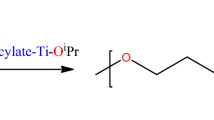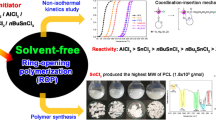Abstract
The structure–reactivity relationship of titanium(IV) alkoxides (Ti(OR)4; R = n-propoxide, n-butoxide, tert-butoxide and 2-ethylhexoxide) in the ring-opening polymerization of ε-caprolactone (ε-CL) has been successfully investigated by differential scanning calorimetry (DSC) technique. Based on isothermal method, the kinetic results demonstrated that the polymerization rate decreased with increasing chain length and bulkiness of alkoxy group of Ti(OR)4. The determined activation energy (Ea) from autocatalytic model (f(α) = αm(1 − α)n) for titanium(IV) n-propoxide, n-butoxide, tert-butoxide and 2-ethylhexoxide were found to be 77.7, 97.2, 105.2 and 97.9 kJ/mol. From thermodynamics analysis of transition state (TS) formulation, the obtained activation enthalpy (∆H≠) values revealed that the titanium(IV) n-propoxide required the lowest energy to form the TS with ε-CL. From the obtained activation entropy (∆S≠) values, it was found that the stability of TS of ε-CL with titanium(IV) n-propoxide was higher than n-butoxide, 2-ethylhexoxide and tert-butoxide. From the overall results, it is clearly indicated that the steric hindrance of Ti(OR)4 initiators plays an important role on the kinetics and thermodynamics of polymerization process. The reactivity of Ti(OR)4 initiators was determined in the order of: titanium(IV) n-propoxide > n-butoxide ≈ 2-ethylhexoxide > tert-butoxide. The polymerization mechanism of all Ti(OR)4 initiators with ε-CL was proposed through the coordination-insertion mechanism.
Graphical abstract

Similar content being viewed by others
References
Cabaret OD, Vaca BM, Bourissou D (2004) Controlled ring-opening polymerization of lactide and glycolide. Chem Rev 101:6147–6176
Hamad K, Kaseem M, Yang HW, Deri F, Ko YG (2015) Properties and medical applications of polylactic acid: a review. Express Polym Lett 5:435–455
Girdthep S, Worajittiphon P, Leejarkpai T, Molloy R, Punyodom W (2016) Effect of silver-loaded kaolinite on real ageing, hydrolytic degradation, and biodegradation of composite blown films based on poly(lactic acid) and poly(butylene adipate-co-terephthalate). Eur Polym J 82:244–259
Stridsberg KM, Ryner M, Albertsson AC (2002) Controlled ring-opening polymerization: polymers with designed macromolecular architecture. Adv Polym Sci 157:41–65
Pretula J, Slomkowski S, Penczek S (2016) Polylactides—methods of synthesis and characterization. Adv Drug Deliv Rev 107:3–16
Albertsson AC, Varma IK (2003) Recent developments in ring opening polymerization of lactones for biomedical applications. Biomacromolecules 4:1466–1486
Hao P, Yang Z, Li W, Ma X, Roesky HW, Yang Y, Li J (2015) Aluminum complexes containing the C-O–Al–O–C framework as efficient initiators for ring-opening polymerization of ε-caprolactone. Organometallics 34:105–108
Contreras JM, Medina D, Carrasquero DL, Contreras RR (2013) Ring-opening polymerization of ε-caprolactone initiated by samarium acetate. J Polym Res 20:244
Chmura AJ, Cousins DM, Davidson MG, Jones MD, Lunn MD, Mahon MF (2008) Robust chiral zirconium alkoxide initiators for the room-temperature stereoselective ring-opening polymerisation of rac-lactide. Dalton Trans 11:1437–1443
Jedrzkiewicz D, Czelusniak I, Wierzejewska M, Szafert S, Ejfler J (2015) Well-controlled, zinc-catalyzed synthesis of low molecular weight oligolactides by ring opening reaction. J Mol Catal A 396:155–163
Routaray A, Nath N, Mantri S, Maharana T, Sutar AK (2015) Synthesis and structural studies of copper(II) complex supported by –ONNO– tetradentate ligand: efficient catalyst for the ring-opening polymerization of lactide. Chin J Catal 36:764–770
Karidi K, Mantourlias T, Seretis A, Pladis P, Kiparissides C (2015) Synthesis of high molecular weight linear and branched polylactides: a comprehensive kinetic investigation. Eur Polym J 72:114–128
Yamada T, Jung D, Sawada R, Tsuchiya T (2008) Intracerebral microinjection of stannous 2-ethylhexanoate affects dopamine turnover in cerebral cortex and locomotor activity in rats. J Biomed Mater Res B 87B(2):381–386
Cooney JJ (1995) Organotin compounds and aquatic bacteria: a review. Helgoländer Meeresun 49:663–677
Li CY, Yu CJ, Ko BT (2013) Facile synthesis of well-defined titanium alkoxides based on benzotriazole phenoxide ligands: efficient catalysts for ring-opening polymerization of cyclic esters. Organometallics 32:172–180
Kim E, Shin EW, Yoo IK, Chung JS (2009) Ring-opening polymerization of l-lactide with silica supported titanium alkoxide catalysts. Macromol Res 17:346–351
Li P, Zerroukhi A, Chen J, Chalamet Y, Jeanmaire T, Xia Z (2009) Synthesis of poly(ɛ-caprolactone)-block-poly(n-butyl acrylate) by combining ring-opening polymerization and atom transfer radical polymerization with Ti[OCH2CCl3]4 as difunctional initiator: I. Kinetic study of Ti[OCH2CCl3]4 initiated ring-opening polymerization of ɛ-caprolactone. Polymer 50:1109–1117
Li P, Zerroukhi A, Chen J, Chalamet Y, Jeanmaire T, Xia Z (2008) Kinetics study of Ti[O(CH2)4OCH=CH2]4 initiated ring-opening polymerization of ε-caprolactone by differential scanning calorimetry. J Appl Polym Sci 110:3990–3998
Meelua W, Molloy R, Meepowpan P, Punyodom W (2012) Isoconversional kinetic analysis of ring-opening polymerization of ε-caprolactone: steric influence of titanium(IV) alkoxides as initiators. J Polym Res 19:9799
Limwanich W, Meepowpan P, Kungwan N, Punyodom W (2020) Influence of butyl group of tin chloride initiators on the non-isothermal DSC ring-opening polymerization of ε-caprolactone: the studies of kinetics, mechanism and polymer synthesis. Thermochim Acta 683:178458
Limwanich W, Meepowpan P, Kungwan N, Punyodom W (2016) Kinetic and mechanistic investigation of the ring-opening polymerization of l-lactide initiated by nBu3SnOnBu using 1H-NMR. Reac Kinet Mech Cat 119:381–392
Limwanich W, Khunmanee S, Kungwan N, Punyodom W, Meepowpan P (2015) Effect of tributyltin alkoxides chain length on the ring-opening polymerization of ε-caprolactone: kinetics studies by non-isothermal DSC. Thermochim Acta 599:1–7
Hernandez AR, Richa AM (2010) Ring opening polymerization of ε-caprolactone initiated by decamolybdate anion: determination of kinetic and thermodynamic parameters by DSC and 1H-NMR. J App Polym Sci 115:2288–2295
Punyodom W, Limwanich W, Meepowpan P (2017) Tin(II) n-butyl l-lactate as novel initiator for the ring-opening polymerization of ε-caprolactone: kinetics and aggregation equilibrium analysis by non-isothermal DSC. Thermochim Acta 655:337–343
Limwanich W, Punyodom W, Kungwan N, Meepowpan P (2015) DSC kinetics analysis for the synthesis of three-arms poly(ε-caprolactone) using aluminum tri-sec-butoxide as initiator. Int J Chem Kinet 47:734–743
Su YC, Yei DR, Chang FC (2005) The kinetics of B-a and P-a type copolybenzoxazine via the ring opening process. J App Polym Sci 95:730–737
Vyazovkin S, Burnham AK, Criado JM, Perez-Maqueda LA, Popescu C, Sbirrazzuoli N (2011) ICTAC kinetics committee recommendations for performing kinetic computations on thermal analysis data. Thermochim Acta 520:1–19
Eyring H (1935) The activated complex in chemical reactions. J Chem Phys 3:107–115
Sedush NG, Chvalun SN (2015) Kinetics and thermodynamics of l-lactide polymerization studied by differential scanning calorimetry. Eur Polym J 62:198–203
Silawanich A, Muangpil S, Kungwan N, Meepowpan P, Punyodom W, Lawan N (2016) Theoretical study of efficiency comparison of Ti(IV) alkoxides as initiators for ring-opening polymerization of ε-caprolactone. Comput Theor Chem 1090:17–22
Acknowledgements
The authors wish to thanks the financial supports from Chiang Mai University (WP and PM), the Thailand Research Fund (TRF) (MRG6080164) (WL) and Office of the Higher Education Commission (OHEC) (WL). The Department of Chemistry and Materials Science Research Center, Faculty of Science, Chiang Mai University, Faculty of Sciences and Agricultural Technology, Rajamangala University of Technology Lanna and University of Phayao are also acknowledged.
Author information
Authors and Affiliations
Corresponding author
Additional information
Publisher's Note
Springer Nature remains neutral with regard to jurisdictional claims in published maps and institutional affiliations.
Rights and permissions
About this article
Cite this article
Limwanich, W., Meelua, W., Meepowpan, P. et al. Kinetics and thermodynamics studies of the ring-opening polymerization of ε-caprolactone initiated by titanium(IV) alkoxides by isothermal differential scanning calorimetry. Reac Kinet Mech Cat 135, 881–895 (2022). https://doi.org/10.1007/s11144-022-02184-z
Received:
Accepted:
Published:
Issue Date:
DOI: https://doi.org/10.1007/s11144-022-02184-z












